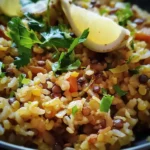Ingredients
Scale
- 1 tablespoon Olive Oil or Avocado Oil: Provides healthy fats for sautéing the aromatics and adds a subtle richness. You can also use ghee for a nuttier flavour.
- 1 large Yellow Onion, finely chopped: Forms the aromatic base of the pilaf, lending sweetness and depth when sautéed.
- 2-3 cloves Garlic, minced: Adds pungent warmth and essential flavour that complements the onion and spices.
- 1 teaspoon Ground Cumin: Offers a warm, earthy, slightly smoky flavour crucial to many pilaf dishes.
- 1 teaspoon Ground Coriander: Provides a slightly sweet, citrusy, and earthy note that pairs beautifully with cumin.
- ½ teaspoon Turmeric Powder: Adds a vibrant golden colour and a warm, peppery, slightly bitter taste with known anti-inflammatory properties.
- ¼ teaspoon Cayenne Pepper (optional): For those who enjoy a gentle kick of heat; adjust amount to your preference or omit entirely.
- ½ teaspoon Salt (or to taste): Enhances all the flavours; adjust based on the saltiness of your broth.
- ¼ teaspoon Black Pepper, freshly ground: Adds a pungent bite and rounds out the spice profile.
- 1 cup Brown Rice (long or short grain), rinsed thoroughly: The hearty, nutty base of the pilaf. Rinsing removes excess starch for fluffier grains. Basmati or Jasmine brown rice varieties work well.
- ½ cup Green or Brown Lentils, picked over and rinsed: These lentils hold their shape well during cooking, adding protein, fiber, and a pleasant, tender texture. Do not use red lentils as they will turn mushy.
- 3 ½ cups Vegetable Broth or Water: The cooking liquid for the rice and lentils. Using broth adds significantly more flavour than water alone. Ensure it’s low-sodium if you’re controlling salt intake.
- 1 Bay Leaf: Infuses a subtle herbal aroma and background flavour during the simmering process. Remember to remove it before serving.
- Fresh Parsley or Cilantro, chopped (for garnish): Adds a burst of fresh, herbaceous flavour and colour right before serving.
- Toasted Nuts or Seeds (optional, for garnish): Sliced almonds, chopped walnuts, pumpkin seeds, or sunflower seeds add a delightful textural crunch.
Instructions
- Prepare the Aromatics: Heat the olive oil (or your chosen fat) in a large pot or Dutch oven with a tight-fitting lid over medium heat. Once the oil shimmers slightly, add the finely chopped yellow onion. Sauté for about 5-7 minutes, stirring occasionally, until the onion becomes soft, translucent, and slightly golden. Don’t rush this step; softened onions provide a crucial sweet base flavour.
- Bloom the Spices: Add the minced garlic, ground cumin, ground coriander, turmeric powder, and optional cayenne pepper to the pot with the onions. Stir constantly for about 1 minute until the spices become highly fragrant. This process, known as blooming, toasts the spices lightly, intensifying their flavour and aroma. Be careful not to burn the garlic or spices.
- Incorporate Rice and Lentils: Add the thoroughly rinsed brown rice and the rinsed green or brown lentils to the pot. Stir well to coat the grains and lentils evenly with the spiced oil mixture. Continue to stir and toast for another 1-2 minutes. This helps the grains absorb flavour and can contribute to a better final texture.
- Add Liquid and Seasoning: Pour in the vegetable broth (or water). Add the salt, freshly ground black pepper, and the bay leaf. Stir everything together well, ensuring nothing is stuck to the bottom of the pot.
- Bring to a Boil: Increase the heat to medium-high and bring the liquid to a rolling boil.
- Simmer Gently: Once boiling, immediately reduce the heat to the lowest possible setting that maintains a very gentle simmer. Cover the pot tightly with the lid. A tight seal is crucial for trapping steam and cooking the rice and lentils evenly. If your lid isn’t tight, you can place a piece of aluminum foil between the pot and the lid before securing it.
- Cook Undisturbed: Let the pilaf simmer gently, covered and undisturbed, for 45-55 minutes. The exact time can vary depending on your specific type of brown rice, the age of your lentils, and the heat of your stove. Resist the urge to lift the lid frequently, as this releases steam needed for cooking.
- Check for Doneness: After about 45 minutes, you can quickly check if the liquid has been absorbed and the rice/lentils are tender. Tilt the pot slightly; there should be no pooled liquid at the bottom. Taste a few grains of rice and a lentil – they should be cooked through but not mushy. If still firm or liquid remains, cover again and cook for another 5-10 minutes.
- Rest Off Heat: Once the liquid is absorbed and the grains/lentils are tender, turn off the heat completely. Leave the pot covered and let the pilaf rest undisturbed for at least 10 minutes. This crucial resting step allows the residual steam to finish cooking the grains and helps them become fluffier and separate.
- Fluff and Serve: Remove and discard the bay leaf. Use a fork (not a spoon) to gently fluff the brown rice and lentil pilaf, separating the grains. Stir in most of the chopped fresh parsley or cilantro, reserving some for garnish. Serve hot, garnished with the remaining fresh herbs and optional toasted nuts or seeds.
Nutrition
- Serving Size: one normal portion
- Calories: 420
- Fiber: 15g
- Protein: 18g
